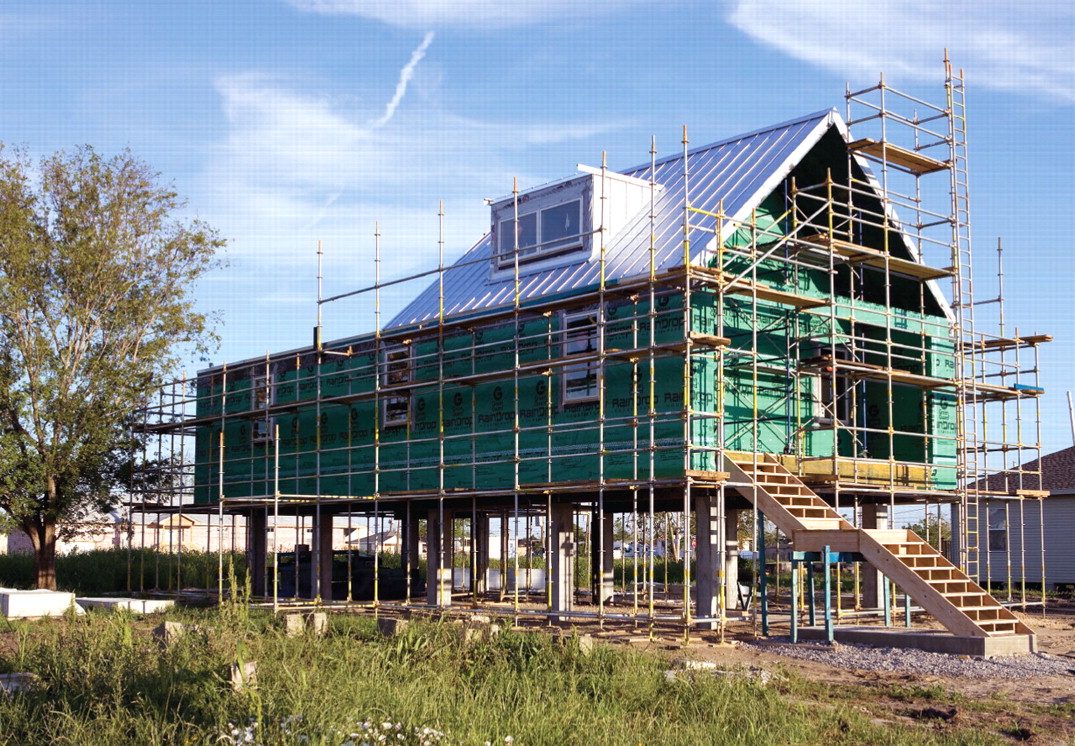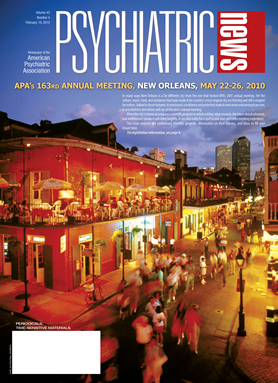“No one walking down St. Charles Street after Katrina could imagine how much the city has come back,” said New Orleans novelist Tom Piazza. “Today the restaurants and clubs are rockin' and rollin', and the Saints did wonders for the city's morale [by making it to the Superbowl], but it's also shocking to see how little has changed.”
Recovery Varies
In fact, New Orleans' recovery from Hurricane Katrina varies with geography and the resources of the inhabitants, said Piazza, who has written on post-Katrina New Orleans in a novel, City of Refuge, and an extended essay, “Why New Orleans Matters.”
“Even to speak of ‘the city’ is misleading,” said Piazza, in an interview with Psychiatric News. “Different social and economic groups give you different answers.”
Statistics only hint at how the city has changed. Orleans Parish's population fell from 461,600 on July 1, 2005, two months before the storm, to 210,768 a year later. The U.S. Census Bureau estimated that the population had risen back to 336,644 by 2008, the latest available data.
The vast physical and human disruption caused by the storm and the failure of the levees only heightened the city's sense of precariousness.
“There's an abnormally high level of tension between extraordinary affirmations of hope and possibility and extraordinary levels of greed, venality, and crime,” said Piazza. “It's hard to live with opposing levels of hope and despair simultaneously.”
A ride around town offers alternate vistas of that hope and despair. The less-damaged and better-insured sections are doing well. The low-income neighborhoods, out of sight of most visitors, are still struggling.
For instance, in the downtown area around the Morial Convention Center, where many APA annual meeting sessions will be held, things are even better than before Katrina, said New Orleans psychiatrist Edward Foulks, M.D., Ph.D. “Anything around there that was messed up was fixed up.”
In the newer-and-better category is the National World War II Museum on Magazine Street, which Foulks described as “spectacular.”
French Quarter Rebounded Quickly
Not far away, the French Quarter, the city's original home, is built largely above flood lines and has steadily returned to life as a choice residential, dining, and entertainment district.
The French Quarter anchors a great swath of the east bank of the Mississippi River—the part that actually looks like it's north of the river on the map.
Flood damage there was minimal because the ground is surprisingly higher closer to the river. However, many buildings in those areas suffered wind damage or were struck by falling trees during the hurricane.
Life in those areas, roughly paralleling the historic St. Charles Avenue streetcar line, has bounced back to normal. The grand Victorian mansions of the Garden District and Uptown look as impressive as ever. New shops and restaurants along Magazine Street have become trendy haunts for 20-somethings from nearby Tulane University and elsewhere, said Foulks, the medical director of the East Jefferson Parish Human Services Agency.
Reconstruction has varied in other parts of the city, such as residential areas along Lake Ponchartrain, depending on residents' private resources.
However, neighborhoods like the Lower Ninth Ward remain devastated, said Foulks.
Actor Brad Pitt created the Make It Right Foundation, which invited top architects to design 150 affordable houses for flood victims in the Lower Ninth Ward. Many are built on stilts to keep them above any future high water.
“This is an interesting experiment, but it is not affecting large numbers of people,” said Foulks.
Medical Facilities Still in Recovery Mode
Of more interest to APA members may be the transformation of the region's medical infrastructure.
“The Tulane and Louisiana State University systems are alive and present in New Orleans,” said Foulks. “But Katrina destroyed the public Charity Hospital and the Veterans Administration Hospital across the street.”
Charity Hospital is still closed, and the VA is open only as a clinic. Patients and clinicians are now scattered around the city and the region.
“We have moved from a centralized, downtown health care system to a de facto community one,” said Foulks.
VA patients are sent to community hospitals for inpatient care. Many residents and students at the city's two medical schools who would have trained at Charity or the VA hospital now rotate through scattered sites elsewhere in New Orleans or 20, 30, 50, or more miles away.
Almost five years after the storm, city, state, and federal officials are still debating whether to refurbish the developed hospitals or start from scratch on a tract of land in the Mid-City area north of downtown ruined by Katrina.
Inpatient services in the city are minimal now. Closure of the New Orleans Adolescent Hospital last summer meant transfer of patients to state mental hospitals in Mandeville and Jackson, both extended drives away for patients' families (Psychiatric News, September 18, 2009).
“Many people have major scars from Katrina and its aftermath,” said Foulks. “People with preexisting schizophrenia, bipolar disorder, or depression often developed PTSD. Some could not take [the hardships] and presented a clinical challenge to the system, but many people came out of the experience with a new role in life. It brought out the best in them.”
“There is a resilience, a spiritual toughness here,” agreed Piazza.
“In New Orleans, especially among African Americans, there are deep, ritualized strategies for dealing with mortality and entropy,” he said. “The traditional New Orleans jazz funeral includes both ritual grieving and also an acknowledgement of the continuity of life. Where else in America do you have exuberant dance music played at a funeral? It encourages a disposition that adjusts to the hard facts of life in an explosion of grace.”


